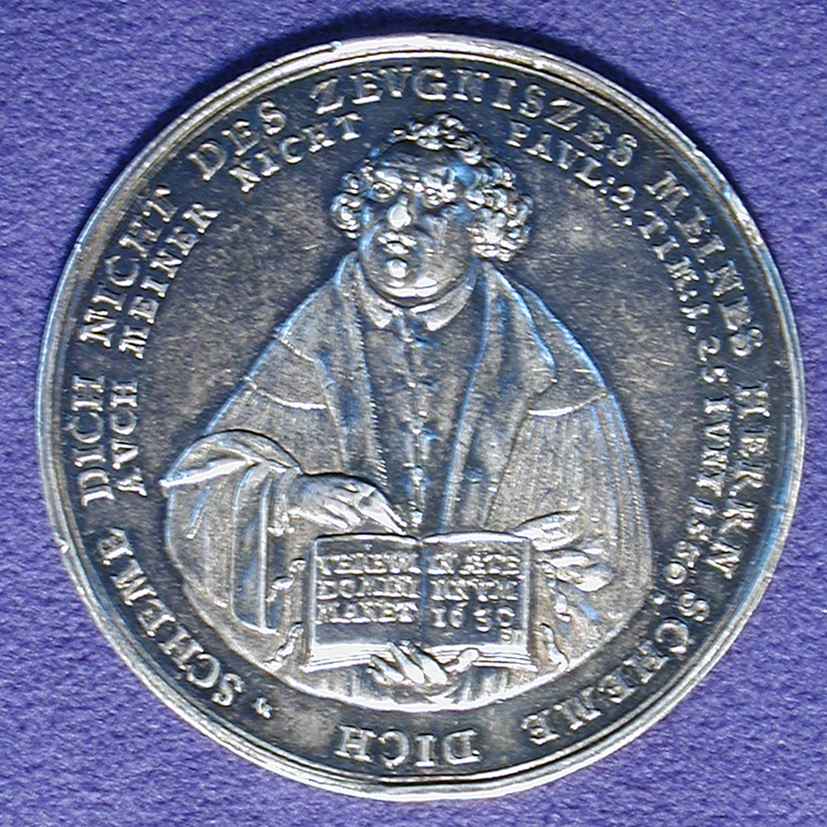

Historical
and Commemorative Medals
Collection of Benjamin Weiss


|
CENTENARY OF THE AUGSBURG CONFESSION: MARTIN LUTHER DADLER, Sebastian, Germany, 1630, Silver, 54 mm This medal was struck to commemorate the one hundredth anniversary of the Augsburg Confession and the role Martin Luther (1483-1546), the seminal figure in the Protestant reformation, played in drafting this document. The Augsburg Confession was the most important Protestant statement of belief written at the time of the Reformation. It was presented to the emperor Charles V at the Diet of Augsburg, on June 25,1530. Compiled by Melanchthon, based on articles previously drawn up by Martin Luther, it has become the classical statement of Lutheran doctrine. The Augsburg Confession consists of 28 articles presented by Lutheran princes and representatives of "free cities" at the Diet of Augsburg that set forward what the Lutherans believed, taught and confessed in positive (theses) and negative (antitheses) statements. The theses are 21 Chief Articles of Faith describing the normative principles of Christian faith held by the Lutherans; the antitheses are seven statements describing what they viewed as abuses of the Christian faith present in the Roman church. Martin Luther, who in the 16th century ushered in the Protestant Reformation, is considered to be one of the great historic figures and most important reformers of the Roman Catholic Church. An assessment of his life's work and in particular his later published materials, however, is controversial. On the one hand, he was critical of what he saw as some of the shortcomings of the Catholic Church, particularly with their practice of issuing indulgences (simply put, an indulgence was a payment to the Catholic Church that purchased an exemption from punishment or penance for some types of sins), and began a period of reform that revolutionized Christian theology. On the other hand, Luther=s later writings were unquestionably virulently anti-Semitic and served as a theological basis for the subsequent hatred, persecution and ultimate massacre of the Jewish people. Martin Luther's major work on the Jews was published in 1543, a 65,000‑word treatise Von den Juden und Ihren Lügen (On the Jews and Their Lies). In it he states that the Jews are a "base, whoring people, that is, no people of God, and their boast of lineage, circumcision, and law must be accounted as filth@. They are full of the "devil's feces ... which they wallow in like swine@. The synagogue was a "defiled bride, yes, an incorrigible whore and an evil slut ...@. He argues that their synagogues and schools be set on fire, their prayer books destroyed, rabbis forbidden to preach, homes razed, and property and money confiscated. They should be shown no mercy or kindness, afforded no legal protection, and these "poisonous envenomed worms" should be drafted into forced labor or expelled for all time. He also seems to advocate their murder, writing "[w]e are at fault in not slaying them@. These sentiments and actions could clearly be seen as harbingers of the horrific actions of the Nazis during the Holocaust (Shoah). (Various sources from Wikipedia). For another medal by Sebastian Dadler commemorating the centennial of the Augsburg Confession, see: CENTENARY OF THE AUGSBURG CONFESSION: JOHN GEORGE I, ELECTOR OF SAXONY. LINK to the Augsburg Confession (from Wikipedia) LINK to Text of the Augsburg Confession, 1530 (from Project Wittenberg) LINK to Portrait of Martin Luther (by Lucas Cranach the Elder) (Wikimedia) LINK to Biography of Martin Luther (from Wikipedia) |
|